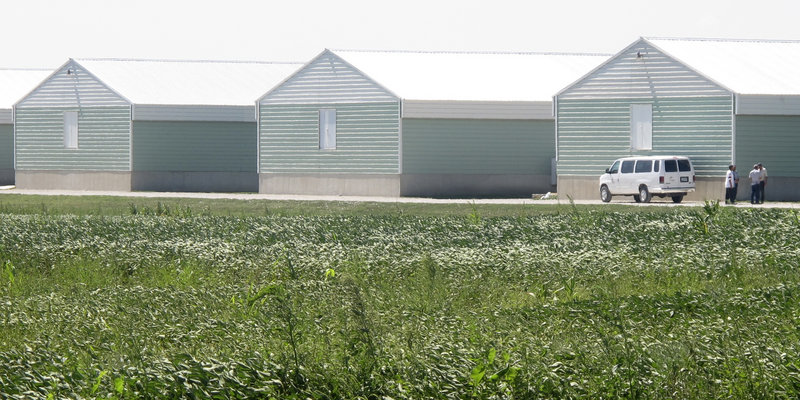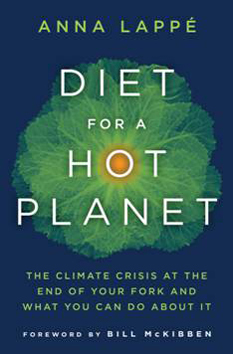The massive recent egg recall reveals how much our food actually costs. As Americans, our food is abundant and the price at the checkout is remarkably cheap. But the costs don’t end there.
We pay the full price for our food in doctor visits, environmental clean-ups, antibiotic resistance, loss of farmland to sprawl, dead zones in the ocean and property damaged by global warming-fueled storms.
And some of us pay for it with our lives after consuming tainted food.
The recall of 500 million eggs due to salmonella contamination makes it difficult to ignore the stark realities of our industrial agriculture system, where filthy factory farms, toxic petro-chemicals, adulterated animal feed, massive feces lagoons, chronic soil degradation and fragile monocultures have become the norm.
As Jonathan Safran Foer writes in “Eating Animals,” “For each food animal species, animal agriculture is now dominated by the factory farm – 99.9 percent of chickens raised for meat, 97 percent of laying hens, 99 percent of turkeys, 95 percent of pigs, and 78 percent of cattle.” The story is the same for our fruits, vegetables and grains.
So what does this egg recall reveal to us about our food system? I talked with three local experts well-versed in this subject and came up with five crucial things we all need to know about what we’re eating.
1. FACTORY FARMS BREED DISEASE
When we confine animals in cages so small they can’t move and force them to live in feces, it doesn’t take a microbiologist to realize such an environment is a pathogen’s dream.
As a result, factory farming has given us mad cow disease, bird-flu, E. coli 0157:H7 and antibiotic-resistant strains of MRSA.
“What we’ve got now are microbes, such as E. coli 0157:H7, that were not common in the past and seem to have originated in feedlots and are now ubiquitous in the environment,” said Russell Libby, executive director of the Maine Organic Farmers and Gardeners Association.
In Michael Pollan’s game-changing book “The Omnivore’s Dilemma,” he wrote: “Escherichia coli 0157:H7 is a relatively new strain of the common intestinal bacteria (no one had seen it before 1980) that thrives in feedlot cattle, 40 percent of which carry it in their gut. Ingesting as few as 10 of these microbes can cause a fatal infection; they produce a toxin that destroys human kidneys.”
Feedlots for cattle aren’t the only places that brew up new and more deadly diseases. Any place where animals are stuffed into overcrowded, filthy conditions, disease finds a happy home.
“Battery cage facilities have up to seven times the odds of getting salmonella as a cage-free system,” said Katie Lisnik, director of the Maine chapter of the Humane Society of the United States, in reference to the egg industry.
2. OLD MACDONALD’S FARM IS A MYTH
Unless all the food you eat comes from the farm stand down the road or your backyard garden, you too are consuming industrial food.
But few people look at their hamburger, salad, breakfast cereal or slice of American cheese and picture it coming from a factory.
“The image in everyone’s head is Old MacDonald’s Farm,” Libby said. “And there’s an assumption reinforced by marketing that everything we eat comes from that archetypal farm. But those archetypal farms are the ones most under attack.”
Libby pointed to Maine’s struggling dairy farms, where the average farmer milks 100 cows a day and the largest milks 1,500 cows. In comparison, he cites the nation’s largest dairy farm in California, which milks 90,000 cows a day.
“The national prices are determined by how inexpensive the milk, cheese and butter is from that farm,” Libby said.
The eggs in the latest recall tell a similar story. Despite selling under 24 different brands, all 500 million of the eggs originated from just two factory farms in Iowa. And while Iowa and Maine are thousands of miles apart, we’re linked by factory farming’s pervasive tentacles.
One of the Iowa farms involved in the recall is owned by factory farmer Jack DeCoster, and both are supplied with young chickens and feed by another company DeCoster owns.
Mainers will remember DeCoster as the man who paid $2 million in fines due to health and safety violations at his Turner egg facility (one of the two largest egg farms in the state) in 1996 and then paid another $125,000 in fines this summer after hidden-camera footage revealed extensive animal cruelty at the same Maine facility.
“It’s a well-kept secret that everything is so consolidated,” Lisnik said.
3. SAFETY LAWS ENCOURAGE CONSOLIDATION AND HURT SMALL FARMERS
As a result of the egg recall, the Food Safety Modernization Act pending before the U.S. Senate has garnered increased attention. The bill calls for new safety procedures, expanded record keeping and additional fees.
An irony is that agribusiness hasn’t had much to say about the bill, but small producers view it as another nail in the coffin of family farming.
“We’ve been really involved in trying to get the federal legislation to be a little more flexible,” said Libby, who has traveled to Washington, D.C., numerous times this summer to lobby for regulations that recognize the difference in scale between factory farms and family farms.
This phenomenon of regulations that are intended to curb food safety problems but actually fuel further industry consolidation is written about most succinctly in sustainable farmer Joel Salatin’s “Everything I Want to Do Is Illegal: War Stories From the Local Food Front.”
“A lot of the policies end up hurting small farmers that had nothing to do with creating the problems,” said Don Lindgren, who heads Slow Food Portland and owns the Rabelais food bookstore in Portland.
Slow Food is an international movement that began in Italy in 1986 as a reaction to the arrival of McDonald’s in Rome. The organization celebrates local food traditions and advocates for a shift away from industrial food.
“Every small producer is not going to be safer than a large producer,” Lindgren said. “The difference with small, local food production is if a problem occurs, it’s localized and you can deal with it locally.”
4. THE AMERICAN AGRICULTURE SYSTEM EXPECTS FOOD TO BE TAINTED
Last Thursday, the headline on the front of this newspaper read: “Eggs of infected Iowa hens will be pasteurized and sold.” If you continued reading, you learned: “It’s a common if little-known practice in the food industry – salvaging and selling products that may have been tainted with disease.”
“The system has been engineered to be efficient and to provide a lot of calories as opposed to quality food,” Lindgren said.
One of the earliest examples of contaminated food trumping clean food comes from the late 1800s, when cities swelled with the Industrial Revolution and demand for milk rose. Unclean dairies sprang up in cities, where cows were fed a waste product from distilleries. The resulting milk was contaminated, and people began to get sick and die.
Two camps proposed solutions. One wanted to certify disease-free raw milk. The other wanted to take tainted milk and clean it up with pasteurization. Pasteurization won out, and in many states (although not in Maine), raw milk became illegal.
“We tend to put a lot more effort into treatment than prevention,” Lisnik said. “Obviously, prevention takes time and effort, so it almost seems easier to focus on treatment. If we had been more focused on prevention, these intensive confinement facilities would not have started in the first place.”
5. SMALL IS BEAUTIFUL … AND LESS RISKY
The alternative to industrial foods is everywhere here in Maine, where neighbors raise backyard chickens, farmers markets continue to expand and hunters obtain the ultimate free-range meat from the forest.
None of these operations resembles a factory, and all contain the inherent beauty that comes from authenticity.
These are the places where we need to obtain our food.
“The only thing that’s going to change this is a lot of people deciding they’ll step outside the retail market and go direct to fishermen and farmers,” Libby said.
But as Lindgren told me, only 4 percent of the food we consume in Maine was grown or raised in this state.
The other 96 percent comes from the faceless world of agribusiness, where the risk of contamination occurs at every stage in the process.
“Unless you track your products all the way back, you’re never sure where they come from,” Lisnik said. “The industrial food system has taken that away from consumers.
“If you really want to know where food is coming from, buy local and visit the farm.”
Staff Writer Avery Yale Kamila can be contacted at 791-6297 or at: akamila@pressherald.com
Copy the Story Link
Send questions/comments to the editors.




Success. Please wait for the page to reload. If the page does not reload within 5 seconds, please refresh the page.
Enter your email and password to access comments.
Hi, to comment on stories you must . This profile is in addition to your subscription and website login.
Already have a commenting profile? .
Invalid username/password.
Please check your email to confirm and complete your registration.
Only subscribers are eligible to post comments. Please subscribe or login first for digital access. Here’s why.
Use the form below to reset your password. When you've submitted your account email, we will send an email with a reset code.